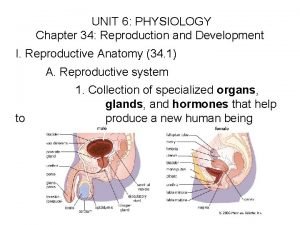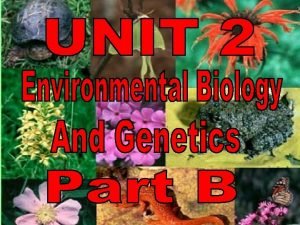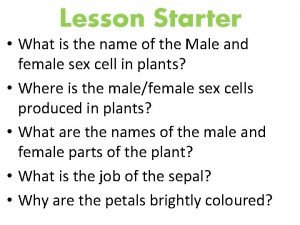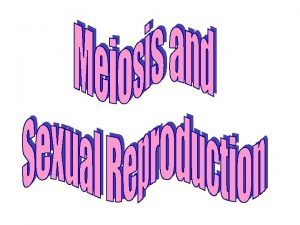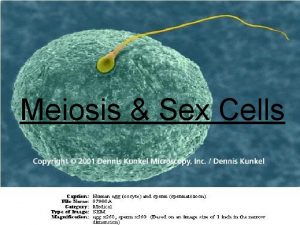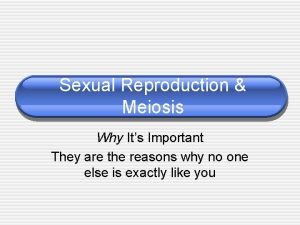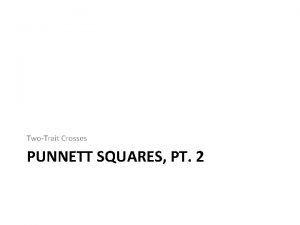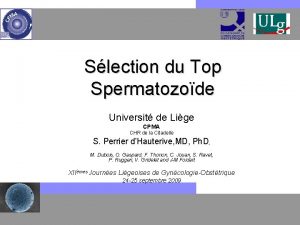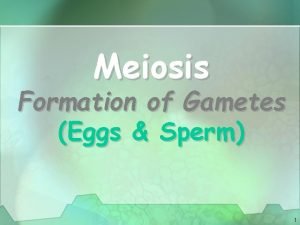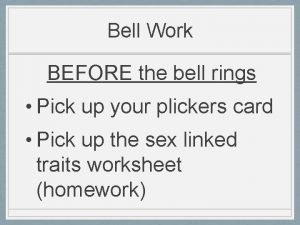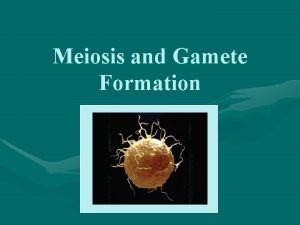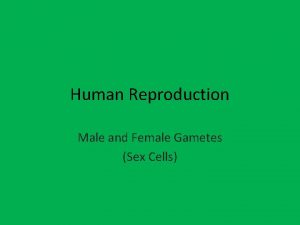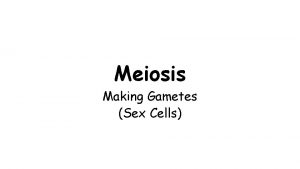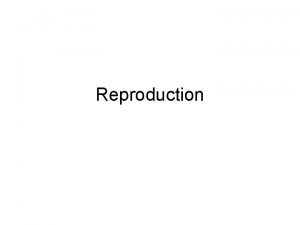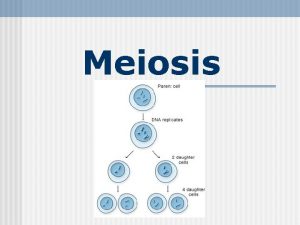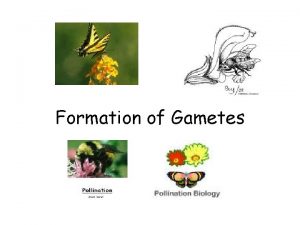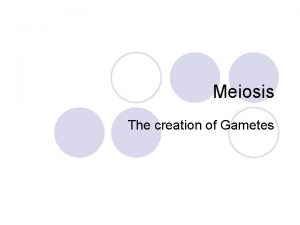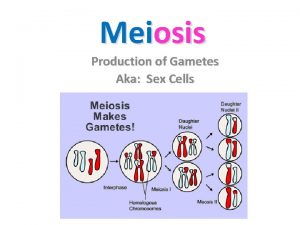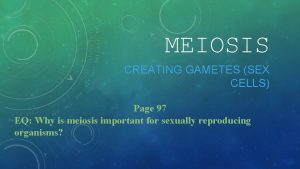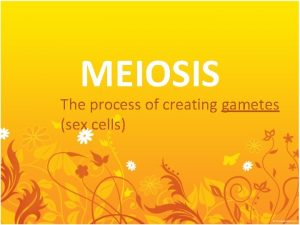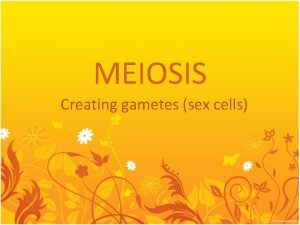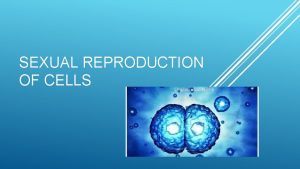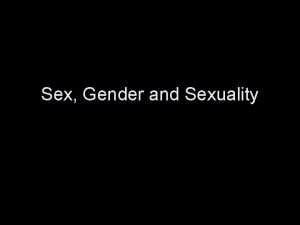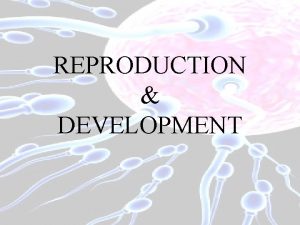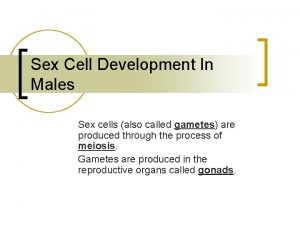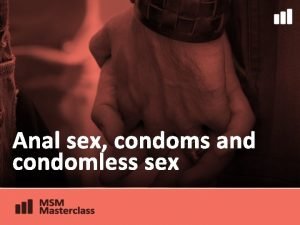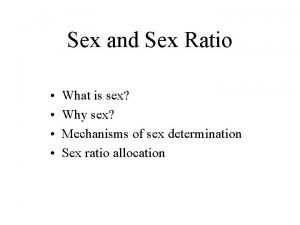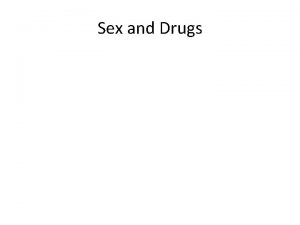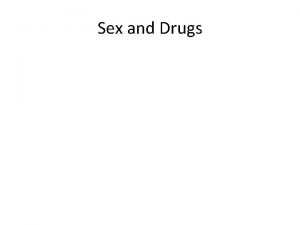Chapter 23 Reproduction and Development Gametes Sex cells








































- Slides: 40

Chapter 23: Reproduction and Development

Gametes: • Sex cells

Sperm: • Male gamete. Head and long tail. • The first part of the tail contains many mitochondria, which provide the energy to swim. • The head contains the nucleus and enzymes to help the sperm enter the egg.


Ova: (singular: ovum) • Female gamete. • Large cell full of nutrients and other materials to help the new life grow.

Gametes are haploid: • Haploid: Containing only one set of chromosomes. • When a haploid sperm and a haploid ovum join, they make a diploid cell (contains two sets of chromosomes), which is the number of chromosomes that all other body cells have.

Fertilization: • Sperm cell joins with the ovum to form a new cell called a zygote. • Zygote combines the chromosomes from the sperm and ovum in its nucleus, making the new diploid cell.

Male reproductive system: • Testes: Male organs that make sperm (and testosterone).

Adult males constantly make new sperm cells. • Epididymis: Collects new sperm cells and stores them until they mature and develop the ability to swim. – Testes and epididymis are suspended in scrotum (pouch of skin that keeps the testes outside the body cavity because sperm need lower temperatures to mature.

• Vas deferens: Tube that carries sperm from epididymis to urethra. Glands add fluids that help move sperm toward the ovum. – Semen: Sperm plus fluids. • Semen leaves the body through the urethra. The penis places semen inside the female reproductive tract.

vas

Female reproductive system: • Ovaries: Make ova. – Newborn girl’s ovaries contain ALL of the cells that will become ova throughout her life. • An oviduct (fallopian tube) is wrapped around each ovary. – Cilia in oviduct sweep released egg toward uterus. – Fertilization usually occurs in the oviduct.

• Uterus: Muscular, pear-shaped organ with a thick lining, in which the fertilized egg implants and develops. – Walls are stretchable as the embryo grows and can produce strong contractions to push the baby out at birth. • Cervix: Opening to uterus. • Vagina (birth canal): Stretchy, muscular tube that opens to the outside of the body.


Menstrual cycle: Female reproductive cycle • Menstruation: Process of shedding the uterine lining.

First week after the start of menstruation: • Pituitary gland releases a hormone that makes an egg develop in an ovary. – Follicle: Case in which ovum develops. • Follicle secretes estrogen, which makes the uterus grow a new lining.

Day 14: • Pituitary hormones make follicle release egg into oviduct. – Ovulation: Release of ovum. • Empty follicle keeps releasing estrogen and starts releases progesterone, which makes the uterine lining grow thicker to support fertilized egg.

• If the egg is not fertilized, it dies and disintegrates. – Uterine lining is shed at the beginning of the next menstrual cycle.

23. 2 Development before birth • Fertilization: Only one sperm can enter the egg. – 2 haploid nuclei become 1 diploid nucleus. – Occurs in the oviduct.

• Zygote divides as cilia push it toward the uterus. – 1 cell 2 cells 4 cells 8 cells…. . – Blastocyst: Hollow ball of cells formed after many divisions


Blastocyst

Pregnant: • The blastocyst has embedded in the uterine lining.

• Some blastocyst cells continue to develop into the new individual, while others form the placenta. – Placenta: Grows into the uterine lining and contacts the mother’s circulatory system to exchange nutrients, oxygen, and wastes between the mother and the offspring. – Umbilical cord: Stalk of tissue that connects embryo to placenta.

Pregnancy • Embryo: Term for the developing individual from the time the blastocyst embeds in the uterine wall to 8 weeks. – 1 week: distinct head and start of digestive tract – 2 weeks: simple, tube-shaped heart – 1 month: 4 buds that will become arms and legs • Now surrounded by amnionic sac: cushions the embryo.

Fetus: • Term for the developing individual from 8 weeks until birth. • At 8 weeks, all organs systems have developed, and the fetus is 4 centimeters long.

During the last 7 months of pregnancy, the fetus: • • • Grows Brain and other organs mature Makes its own blood cells Fat tissue develops under the skin Hair and nails develop Moves felt after 4 th month) • In the ninth month, the fetus is upside down with its head against the cervix, ready to be born.

Birth: • When the fetus’s lungs have matured, they release a protein that crosses the placenta into the mother. • This protein triggers the hormone oxytocin to be released, which causes labor.

• After the baby is born, the placenta is released and expelled. • The umbilical cord is cut and the remaining piece eventually dries and falls off. – The scar becomes the naval (belly button).

Twins: • Fraternal twins: Two eggs are released at the same time and both get fertilized and implant. • Identical twins: Single zygote splits in two. Both individuals have the exact same genes.

23. 3 Human life stages:

Infancy: • From birth to 18 months. • Period of greatest physical and mental changes. • Rapid growth. • Coordination of nervous system and muscles. – Roll over, sit up, grab toys, crawl. Walk by 18 months. • Ability to think and reason grows. • First words said by end of infancy.

Childhood: • From 18 months until puberty (approximately 12 -13 years). • Steady growth and development occurs during this time.

Adolescence: • Puberty through the teens. • The child’s body becomes an adult body. • Hormones cause reproductive organs to mature, making the person fertile (capable of having children).

• Secondary sexual characteristics: Adult physical characteristics.

In boys: • • • Testes release testosterone. Penis and testes grow. Testes start to make sperm. Larynx grows, causes a deeper voice. Body and facial hair develops. Muscles in chest and shoulders get bigger.

In girls: • Ovaries release estrogen. • Hips grow wider. • Breasts develop.

In both boys and girls: • Underarm and pubic hair develops. • Growth spurt: – Girls – ends at 16. – Boys – ends at 18.

Adulthood: • From the end of adolescence to age 60. • No height changes. • After age 45: – Metabolism shows. – Physical strength declines. – Bones become more brittle. – Skin loses elasticity (causes wrinkles). – Hair loses pigment (becomes gray). – Women: Ovaries stop producing estrogen • Menstrual cycle stops (menopause).

Older adulthood: • • • After age 60. Cell division and tissue repair slows. Wrinkles deepen. Eyesight and hearing diminish. Reflexes slow. Response time slows.
 Chapter 8 cellular reproduction cells from cells
Chapter 8 cellular reproduction cells from cells Sex sex sex
Sex sex sex Greenhouse sex
Greenhouse sex Sex sex sex
Sex sex sex Sex sex sex
Sex sex sex Secondary sexual characters
Secondary sexual characters How are mitosis and meiosis similar
How are mitosis and meiosis similar Hare lynx
Hare lynx Sex linkage
Sex linkage Heterogametic
Heterogametic Sex determination and sex linkage
Sex determination and sex linkage Asexual reproduction cell division
Asexual reproduction cell division Sexual vs asexual reproduction venn diagram
Sexual vs asexual reproduction venn diagram Chapter 34 reproduction and development answer key
Chapter 34 reproduction and development answer key Once a sex offender always a sex offender
Once a sex offender always a sex offender Sphenoid paranasal sinus
Sphenoid paranasal sinus Chlorocruorin
Chlorocruorin Comparing animal and plant cells venn diagram
Comparing animal and plant cells venn diagram Masses of cells form and steal nutrients from healthy cells
Masses of cells form and steal nutrients from healthy cells Gametes
Gametes Plant sex cells
Plant sex cells Sex cells
Sex cells Bacteria sexual or asexual
Bacteria sexual or asexual How many chromosomes are in a human's sex cells
How many chromosomes are in a human's sex cells Regulation of tubular reabsorption
Regulation of tubular reabsorption Parafollicular cells vs follicular cells
Parafollicular cells vs follicular cells Somatic cells vs germ cells
Somatic cells vs germ cells Eukaryotic life
Eukaryotic life Prokaryotic cells vs eukaryotic cells
Prokaryotic cells vs eukaryotic cells Why did robert hooke name cells “cells”?
Why did robert hooke name cells “cells”? Younger cells cuboidal older cells flattened
Younger cells cuboidal older cells flattened Prokaryotic cells vs eukaryotic cells
Prokaryotic cells vs eukaryotic cells Is a staphylococcus cell prokaryotic or eukaryotic
Is a staphylococcus cell prokaryotic or eukaryotic Cell substance
Cell substance Two traits punnett square
Two traits punnett square Cpma citadelle
Cpma citadelle Replicated chromosome
Replicated chromosome How to do the foil method in biology
How to do the foil method in biology Dihybrid cross
Dihybrid cross Foil method gametes
Foil method gametes How to foil alleles
How to foil alleles













